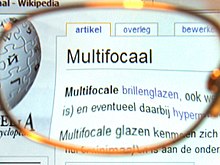Progressive lens
A progressive lens is a special lens with different refractive indices for long-distance and near correction of vision defects and usually a presbyopia ( presbyopia ). In contrast to bifocal and trifocal lenses, in which one or two additional, optically effective areas are incorporated into the distance part, which lead to corresponding image jumps when used and are only designed for two or three static distances, a progressive lens offers a stepped lens - and seamless ability to see clearly at all distances between the individual far and near point. These advantages are put into perspective by visual side effects, a certain amount of getting used to and the high costs.
construction
Varifocal lenses are divided into three merging progression zones:
- upper zone for distance vision or maximum distance for near comfort lenses,
- middle zone for intermediate distances and
- lower zone for near vision.
A distinction is also made between “normal” and “short” varifocal lenses. In order to be able to use all three zones comfortably, these two variants require a minimum height from the center of the pupil to the lower edge of the glass. The average for normal varifocal lenses is 21 mm, for short lenses it is 15 mm. When choosing a small version, make sure that
- Short glasses are used
- the measured height is at least 15 mm,
- the maximum near addition does not exceed 2.0 D, since short lenses cause greater lateral distortions ( imaging errors ) with higher additions .
The optical effect between the far and near parts changes continuously. There is no abrupt transition here, as with conventional multifocal lenses. A high degree of customization and accuracy of fit should ensure that you get used to it as quickly as possible.
Near comfort glass
As so-called near comfort lenses, varifocal lenses cover an extended near range (without the far range) between about 40 and 100 cm and as such are particularly suitable for screen activities ( computer workstation glasses ) or similar areas of use , also because of the progression zones that are adapted to these distances .
advantages
- The smooth transition between the different strengths is often perceived as more pleasant than the hard one with bifocal or trifocal glasses.
- Progressive lenses enable sharp vision even at intermediate distances.
- Progressive lenses are less conspicuous and have an aesthetic advantage in terms of their recognizability.
- If you start wearing it early, it usually takes little time to get used to it.
disadvantage
- When you start wearing them later, it takes a lot more getting used to than with conventional multifocal lenses due to the optical properties.
- Different complaints can occur during the acclimatization phase.
- The viewing areas for distance and near are smaller than with individual glasses and the progression zones are relatively narrow.
- Lines and levels can appear distorted due to rocking effects, especially in the edge zones.
- Estimating distances can be difficult during the familiarization phase.
- The costs for progressive lenses are significantly higher.
Manufacturing
The first progressive lens was developed in France in 1959 and was called Varilux1 . For the first time it was possible for people with ametropia (nearsightedness, farsightedness, asthma) and presbyopia to compensate for this with a single pair of glasses, which can be worn throughout the day. The world's first individual progressive lenses that take into account the personal characteristics of the wearer are said to have been brought onto the market at almost the same time by the German glass manufacturers Rodenstock and Carl Zeiss . The manufacture of progressive lenses is subject to DIN EN ISO 8980.
literature
- DIN Verlag Beuth: DIN EN ISO 8980-1, ophthalmic optics - raw-edged finished spectacle lenses.
- Franz Grehn: Ophthalmology. 30th, revised and updated edition. Springer, Heidelberg 2008, ISBN 978-3-540-75264-6 , p. 344.
- Bernhard Lachenmayr, Annemarie Buser: eye, glasses, refraction. Schober course: understand, learn, apply. 4th, revised edition. Thieme, Stuttgart et al. 2006, ISBN 3-13-139554-0 , p. 135 ff.
- Gian P. Paliaga: The determination of visual acuity (= Ophthalmothek. Vol. 16). Quintessenz, Munich 1993, ISBN 3-86128-204-6 .
- Harald Presser: glasses and eyes. Optics of the eye, ameropia, presbyopia, corrections, binocular vision, disorders and corrections, optics and imaging of visual aids, multifocal lenses and varifocal lenses, selection criteria for spectacle lenses, filter glasses, surface finishing, contact lenses and care products. CHK-Verlag, Stephanskirchen 2001.
Web links
Individual evidence
- ↑ Ilka Schwarz, Martin Zimmermann: Experience more proximity - design tuning for near comfort lenses. ( Memento of the original from October 16, 2014 in the Internet Archive ) Info: The archive link was inserted automatically and has not yet been checked. Please check the original and archive link according to the instructions and then remove this notice. In: Deutsche Optikerzeitung. Issue 4, 2009, ISSN 0344-7103 , pp. 60-64.
- ↑ Progressive lens: manufacture. Retrieved September 7, 2019 .
